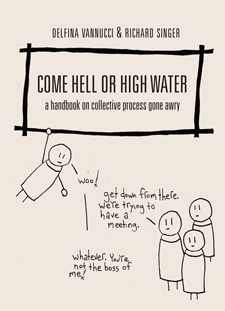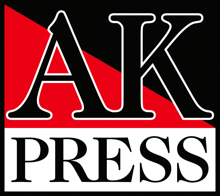Come Hell or High Water: Why is collective process so darn difficult?!
 Hi folks! Those of you who’ve scoured the latest AK Press 2010 catalogue already know that one of the exciting new titles AK Press is releasing this season is a desperately-needed guide to collective process, Come Hell or High Water: A Handbook on Collective Process Gone Awry, by Delfina Vannucci and Richard Singer. We’re really excited about this one! As folks who have invested a great deal of time and energy in a collectively-run business, we’re constantly thinking about questions of collectivity and questions of process and structure, and it never ceases to amaze us how many times issues of process, or gaps in our collective process, come back to bite us in the ass, usually when we least expect it. Like everyone who works in collective settings, our goal is always to resolve potential problems before they become problems … which is why we’re constantly rethinking and evolving the sets of best practices that we use to manage our business, and guide our interactions with each other. But sometimes you just miss things, and situations that seem entirely innocuous upon first glance can turn into major sources of collective strife further down the road. And that’s where Richard and Delfina come in. Their book isn’t a guide to starting a collective (though that’s another long-overdue topic for a good short book!); instead, it’s a handbook for folks who are already familiar with the ways collectives work, and a set of strategies that folks can apply to their own real-world collective settings to get derailed processes back on track. If you’ve worked in a collective, you’ll recognize the situations they describe. You may even see shadows of yourself in some of the inadvertent transgressions they describe—a slightly uncomfortable, but ultimately productive experience!
Hi folks! Those of you who’ve scoured the latest AK Press 2010 catalogue already know that one of the exciting new titles AK Press is releasing this season is a desperately-needed guide to collective process, Come Hell or High Water: A Handbook on Collective Process Gone Awry, by Delfina Vannucci and Richard Singer. We’re really excited about this one! As folks who have invested a great deal of time and energy in a collectively-run business, we’re constantly thinking about questions of collectivity and questions of process and structure, and it never ceases to amaze us how many times issues of process, or gaps in our collective process, come back to bite us in the ass, usually when we least expect it. Like everyone who works in collective settings, our goal is always to resolve potential problems before they become problems … which is why we’re constantly rethinking and evolving the sets of best practices that we use to manage our business, and guide our interactions with each other. But sometimes you just miss things, and situations that seem entirely innocuous upon first glance can turn into major sources of collective strife further down the road. And that’s where Richard and Delfina come in. Their book isn’t a guide to starting a collective (though that’s another long-overdue topic for a good short book!); instead, it’s a handbook for folks who are already familiar with the ways collectives work, and a set of strategies that folks can apply to their own real-world collective settings to get derailed processes back on track. If you’ve worked in a collective, you’ll recognize the situations they describe. You may even see shadows of yourself in some of the inadvertent transgressions they describe—a slightly uncomfortable, but ultimately productive experience!
The book is set to release in January 2010, so preorder your copy today and receive it hot off the presses! And, for groups, organizations, and other collectively-minded businesses, we’re offering a special 50% wholesale rate if you order 10 or more copies (non-returnable), since we suspect folks may want to make the book available to everyone in their collectives and communities as a resource. Just email orders@akpress.org if you’re interested in getting the special wholesale rate for bulk orders.
And, lest you worry about getting bogged down in the depressing—but realistic—failures of collective process, let me sweeten the deal for you: the book’s illustrated with comics courtesy of the ever-incorrigible Strangers in a Tangled Wilderness crew, who’ve sustained us through good times and bad with their timely interventions into anarchist politics in stick-figure form!
Below you’ll find an excerpt from Delfina & Richard’s introduction to the book. We hope this gives you a good sense of what’s in store in Come Hell or High Water, and encourages you to buy the book and start building better processes!
*****
Excerpt from the Introduction to Richard Singer & Delfina Vannucci’s
Come Hell or High Water: A Handbook on Collective Process Gone Awry
Introduction
Being part of an egalitarian collective can be a powerful and liberating experience. Most of us, throughout our lives, have been in groups in the broader society—whether in the workplace, school, or other organizations—in which hierarchies of authority, power, and knowledge are paramount. Each of us is expected either to submit—most of the time—or to lead, if one has made one’s arduous way to the top. Joining a collective, on the other hand, allows an individual to pursue her goals within a common framework, and to help shape that framework with her own contributions. Members are in charge of themselves and one another, without coercion or enforced obedience, and they work cooperatively.
A collective is simply a group of people who come together to work toward a common goal, like creating art or music, organizing around political causes, providing services to a community, or pursuing any objective that the group’s members choose as their focus. Collectives are often made up of volunteers, but they can also form the organizational structure of businesses. Because a collective is made up of individuals whose interests will vary, and vary over time, and because the membership itself will usually change over time, collectives tend to be organic: the group’s activities and goals depend on the composition of the group at a particular time. But the main thing that distinguishes a collective from other organizations is that everyone in the group is considered an equal. There are no authority figures and there’s no hierarchy. Decisions are made collectively by the entire group, whether by consensus (which means that everyone in the group has to, ideally, consent to all decisions) or by voting (whether it’s a majority vote, a two-thirds vote, etc.).
The notion that there must be leaders and followers is so ingrained in our culture that some might think that egalitarianism just can’t work. But there are lots of examples of egalitarian collectives, some that have been around for decades. Food Not Bombs, for instance, has been serving free meals to all takers and to support political actions since the early 80s. It is now is made up of hundreds of autonomous collectives all around the world. The famous punk rock club 924 Gilman Street, in Berkeley, is a collective that has been going strong for over 20 years. (Punk subculture can sometimes be a good model for collectives, but not always—a point we’ll get back to in a later chapter.) The publisher of this book, AK Press, is an example of a collectively run business. And although a collective is typically made up of more than two people, this book was written collectively, with both authors having an equal say.
In an egalitarian collective, everyone is valued, and everyone gets a say without having to worry about being overruled or ordered to conform to someone else’s wishes. It’s a heady ideal. At its best, it stands as a model for a more just and inclusive structure for working and existing together. But equality and fair dealing don’t just flow automatically out of good intentions. Egalitarianism requires commitment and mindfulness from everyone involved. It demands clarity and the willingness to work at it, which sometimes includes hashing out conflicts and working out solutions to tough problems. When the ideal of egalitarianism is allowed to flounder, unattended to, it can devolve right back into the patterns that most of us knew in our lives outside of collectives: hierarchy, mistrust, looking out only for oneself, and sometimes even underhanded scheming.
While every collective is unique, because it’s made up of unique human beings, there are some common problems, as well as common strengths, that we have seen over time. And in our view, they form predictable patterns.
The purpose of this book is to clarify some of the problems that can come up in groups that strive for equality and openness. It’s not meant as a complete manual for how to work in egalitarian groups, nor is it an introduction to the consensus process. (For people seeking thorough texts on those subjects, we recommend the books Building United Judgment: A Handbook for Consensus Decision Making, by the Center for Conflict Resolution, ed., and On Conflict & Consensus: A Handbook on Formal Consensus Decisionmaking, by C.T. Lawrence Butler and Amy Rothstein.) Nonetheless, we hope that these pages will be of some use to any group that chooses to function according to the principles of cooperation and egalitarianism.
Are you hooked? Just wait until you see what comes next! Pre-order a copy today and get 20% off the cover price (an already modest $10!)
